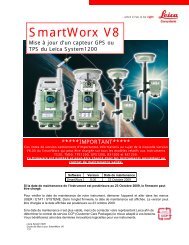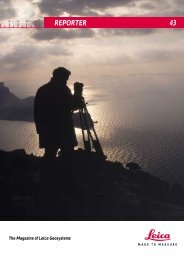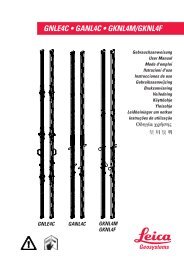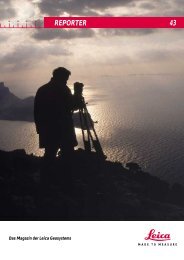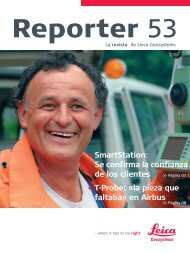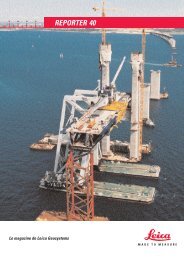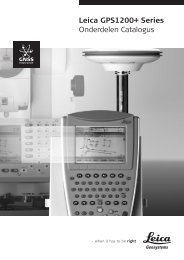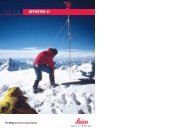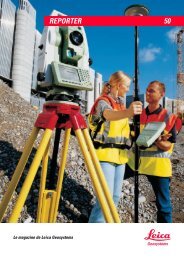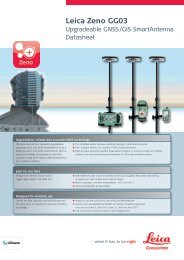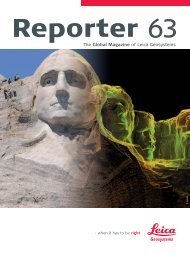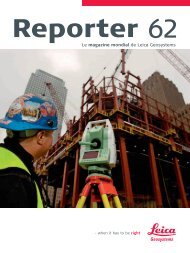Transformations and OSGM02 user guide - Leica Geosystems
Transformations and OSGM02 user guide - Leica Geosystems
Transformations and OSGM02 user guide - Leica Geosystems
- No tags were found...
Create successful ePaper yourself
Turn your PDF publications into a flip-book with our unique Google optimized e-Paper software.
PrefaceThis grid transformation software <strong>and</strong> <strong>user</strong> <strong>guide</strong> has been commissioned by a consortium comprisingOrdnance Survey Great Britain, Ordnance Survey Irel<strong>and</strong> (OSi), <strong>and</strong> Ordnance Survey of Northern Irel<strong>and</strong> (OSNI).These organisations are responsible for the official, definitive topographic mapping of their respective countries.This <strong>user</strong> <strong>guide</strong> contains all the information you need to make effective use of the Ordnance Survey Grid<strong>Transformations</strong> in the UK <strong>and</strong> Irel<strong>and</strong>, <strong>and</strong> the Ordnance Survey Geoid model (<strong>OSGM02</strong>). Within Great Britaincoordinates are transformed using the Ordnance Survey National Grid Transformation (OSTN02). Within the Republicof Irel<strong>and</strong> <strong>and</strong> Northern Irel<strong>and</strong>, the OSi/OSNI Polynomial Transformation is used. <strong>OSGM02</strong> is used to transform heightsthroughout the UK <strong>and</strong> Irel<strong>and</strong>.Users wishing to incorporate the pre-prepared .dll should refer to the Grid InQuest 6.0 <strong>user</strong> <strong>guide</strong>.The intention of this <strong>guide</strong> is to help you underst<strong>and</strong> the information contained in the data, as well as providing detailedtechnical information <strong>and</strong> the data format specification; however it is assumed that <strong>user</strong>s have some appreciation ofcoordinate systems <strong>and</strong> datums. This <strong>user</strong> <strong>guide</strong> has been checked <strong>and</strong> validated before issue <strong>and</strong> every endeavourmade to ensure that the contents are accurate. If you find an error, omission, or otherwise wish to make a suggestion asto how this <strong>user</strong> <strong>guide</strong> can be improved, please contact us at the address shown under Contact details.Contact detailsFor <strong>user</strong>s in Great Britain <strong>and</strong> the Isle of Man:The Geospatial Development Team will be pleased to deal with your enquiries:Email: GIDTechSup@ordsvy.gov.ukor write to:The Geospatial Development TeamOrdnance SurveyRomsey RoadSOUTHAMPTONUnited Kingdom SO16 4GUWeb site: www.gps.gov.uk<strong>Transformations</strong> <strong>and</strong> <strong>OSGM02</strong> <strong>user</strong> <strong>guide</strong> prefacev2.1 9/2002 © crown copyrightPage 1
For <strong>user</strong>s in Northern Irel<strong>and</strong>:Ordnance Survey of Northern Irel<strong>and</strong>Colby HouseStranmillis CourtBelfastNorthern Irel<strong>and</strong>BT9 5BJWeb site: www.osni.gov.ukFor <strong>user</strong>s in the Republic of Irel<strong>and</strong>:Ordnance Survey Irel<strong>and</strong>Phoenix ParkDublin 8Irel<strong>and</strong>Web site: www.osi.ieLiabilityOSTN02 <strong>and</strong> <strong>OSGM02</strong> are provided free of charge by Ordnance Survey ® <strong>and</strong> (where relevant) Ordnance SurveyNorthern Irel<strong>and</strong> <strong>and</strong> Ordnance Survey Irel<strong>and</strong> on an as is <strong>and</strong> as <strong>and</strong> when available basis to <strong>user</strong>s. A <strong>user</strong> ofeither OSTN02, the OSi/OSNI polynomial transformation, or <strong>OSGM02</strong> does so at their own risk. Downloading of anydynamic link library (.dll) files from this site is made without any representation or warranty or condition, whetherexpressed or implied; in particular it is without representation, warranty or condition that OSTN02, the OSi/OSNIpolynomial transformation, <strong>and</strong> <strong>OSGM02</strong> are error free, free from viruses or other harmful components or as to theaccuracy, content, completeness, legality, reliability, quality or suitability of them other than those implied by statute.Ordnance Survey <strong>and</strong> (where relevant) Ordnance Survey Northern Irel<strong>and</strong> <strong>and</strong> Ordnance Survey Irel<strong>and</strong> shall not beliable to a <strong>user</strong> or any third party for any losses, costs, claims or indirect, special, incidental, punitive, or consequentialdamages arising out of access, downloading or use of OSTN02, the OSi/OSNI polynomial transformation, or <strong>OSGM02</strong>.<strong>Transformations</strong> <strong>and</strong> <strong>OSGM02</strong> <strong>user</strong> <strong>guide</strong> prefacev2.1 9/2002 © crown copyrightPage 2
Data copyrightUser <strong>guide</strong> copyrightTrademarksCopyright <strong>and</strong> any database right or other intellectual property right in the OSTN02 data available from this site,however it is made available, belongs to Ordnance Survey (<strong>and</strong> is therefore Crown copyright). Copyright <strong>and</strong> anydatabase right or other intellectual property right in <strong>OSGM02</strong> data available from this site, however it is made available,belongs jointly to Ordnance Survey, Ordnance Survey Northern Irel<strong>and</strong> (<strong>and</strong> is protected by Crown copyright) <strong>and</strong>Ordnance Survey Irel<strong>and</strong>.Ordnance Survey <strong>and</strong> (where relevant) Ordnance Survey Northern Irel<strong>and</strong> <strong>and</strong> Ordnance Survey Irel<strong>and</strong> permit <strong>user</strong>s tocopy or incorporate copyrighted material from both OSTN02, the OSi/OSNI polynomial transformation, or <strong>OSGM02</strong>either onto their own PCs or into their software. However, this is dependant on the appropriate copyright notice beingdisplayed in the software. The appropriate notices are '© Ordnance Survey Irel<strong>and</strong>, 2002' or '© Crown copyright 2002.All rights reserved.' as applicable. The appropriate mapping agency logo must also appear next to the copyrightnotice. Details of mapping agency logos are found in the style <strong>guide</strong>s available on the web site.This <strong>user</strong> <strong>guide</strong> is © Crown copyright 2002. All rights reserved. It accompanies OSTN02 <strong>and</strong> <strong>OSGM02</strong> data to allow youto make effective use of the data. Any part of this <strong>guide</strong> may be copied for business use. Business use is defined asactions related to business decision making or as part of day-to-day operations associated with the running of thebusiness. No part of the <strong>guide</strong> may be copied or incorporated in products, services or publications a <strong>user</strong> generates foronward sale or as free promotional support material, without the prior written permission of Ordnance Survey.Ordnance Survey, the OS Symbol <strong>and</strong> OSGB36 are registered trademarks <strong>and</strong> OSTN02 is a trademark ofOrdnance Survey, the national mapping agency of Great Britain. <strong>OSGM02</strong> is a trademark of Ordnance Survey,Ordnance Survey Northern Irel<strong>and</strong> <strong>and</strong> Ordnance Survey Irel<strong>and</strong>. Ordnance Survey Northern Irel<strong>and</strong>, OSNI <strong>and</strong> theOSNI Symbol are trademarks of Ordnance Survey Northern Irel<strong>and</strong>. The OSi Symbol is a registered trademark ofOrdnance Survey Irel<strong>and</strong>. Ordnance Survey Irel<strong>and</strong> <strong>and</strong> OSi are trademarks of Ordnance Survey Irel<strong>and</strong>.<strong>Transformations</strong> <strong>and</strong> <strong>OSGM02</strong> <strong>user</strong> <strong>guide</strong> prefacev2.1 9/2002 © crown copyrightPage 3
ContentsChapter 1 Introduction ..........................................................................................................................................................................................6Coordinate transformations <strong>and</strong> the Geoid model ...............................................................................................................................6OSTN02 ................................................................................................................................................................................................7OSi/OSNI polynomial transformation ....................................................................................................................................................7Ordnance Survey Geoid model: <strong>OSGM02</strong> ...........................................................................................................................................8ETRS89 explained ................................................................................................................................................................................9Benefits.................................................................................................................................................................................................9Applications........................................................................................................................................................................................10Chapter 2Data overview.....................................................................................................................................................................................11Basic principles..................................................................................................................................................................................11Data structure.....................................................................................................................................................................................12OSTN02/<strong>OSGM02</strong> within Great Britain – format <strong>and</strong> layout of the data........................................................................................12<strong>OSGM02</strong> within Northern Irel<strong>and</strong> – format <strong>and</strong> layout of the data ................................................................................................13<strong>OSGM02</strong> within the Republic of Irel<strong>and</strong> – format <strong>and</strong> layout of the data ......................................................................................15Chapter 3 Ordnance Survey transformations <strong>and</strong> <strong>OSGM02</strong> explained ..............................................................................................................18OSTN02 ..............................................................................................................................................................................................18Transforming ETRS89 coordinates to OSGB36 National Grid: overview ......................................................................................18Calculating which data record to use ...........................................................................................................................................18Procedure for transforming ETRS89 to OSGB36 coordinates ......................................................................................................19Inverse transformation (OSGB36 to ETRS89) ...............................................................................................................................22The OSi/OSNI polynomial transformation ...........................................................................................................................................23Table of coefficients for OSi/OSNI polynomial transformation ......................................................................................................24The Ordnance Survey Geoid model: <strong>OSGM02</strong> ..................................................................................................................................25Chapter 4Quality statement................................................................................................................................................................................27Coverage............................................................................................................................................................................................27Accuracy of Ordnance Survey transformations..................................................................................................................................27Accuracy of <strong>OSGM02</strong>.........................................................................................................................................................................28<strong>Transformations</strong> <strong>and</strong> <strong>OSGM02</strong> <strong>user</strong> <strong>guide</strong> contentsv2.1 9/2002 © crown copyrightPage 4
Appendix A Transforming ETRS89 GPS coordinates to OSGB36 <strong>and</strong> orthometric height.....................................................................................29Worked example...........................................................................................................................................................................29Inverse transformation: OSGB36 to ETRS89 ......................................................................................................................................32Worked example...........................................................................................................................................................................32Appendix B Converting latitude <strong>and</strong> longitude to easting <strong>and</strong> northing ................................................................................................................33Worked example using the Airy 1830 ellipsoid <strong>and</strong> National Grid .....................................................................................................36Appendix C Converting easting <strong>and</strong> northing to latitude <strong>and</strong> longitude ................................................................................................................37Worked example using Airy 1830 ellipsoid <strong>and</strong> National Grid ...........................................................................................................39Appendix D Glossary .............................................................................................................................................................................................40<strong>Transformations</strong> <strong>and</strong> <strong>OSGM02</strong> <strong>user</strong> <strong>guide</strong> contentsv2.1 9/2002 © crown copyrightPage 5
Chapter 1IntroductionCoordinate transformations <strong>and</strong> the Geoid modelAll Ordnance Survey mapping relates to a coordinate reference system. In Great Britain Ordnance Survey coordinatesrelate to OSGB36 ® (the National Grid); within Northern Irel<strong>and</strong> <strong>and</strong> the Republic of Irel<strong>and</strong> the coordinate referencesystem is the Irish Grid. These reference systems are traditionally realised on the earth's surface by monumentedtriangulation stations. The <strong>user</strong>s of mapping products, in both the public <strong>and</strong> private sectors, have invested ingeographical information systems (GIS) <strong>and</strong> asset management systems based on these grid systems, which havebeen accepted as de facto national st<strong>and</strong>ards.The National Grid <strong>and</strong> the Irish Grid are capable of supporting surveying <strong>and</strong> mapping in UK <strong>and</strong> Irel<strong>and</strong> to meet all therequirements of <strong>user</strong>s both now <strong>and</strong> in the future; however, an increasing number of spatial datasets are available inGPS (Global Positioning System) coordinate systems. When two or more coordinate datasets are to be integrated, it isessential that each relates to the same coordinate reference system, irrespective of accuracy issues.In order to relate GPS-derived positions to Ordnance Survey's mapping, GPS coordinates need to be converted to IrishGrid or to National Grid, which requires a specialised datum transformation. For this reason the Ordnance Survey ofNorthern Irel<strong>and</strong> <strong>and</strong> Ordnance Survey Irel<strong>and</strong> have developed a polynomial transformation, which is the st<strong>and</strong>arddatum transformation for use throughout Irel<strong>and</strong>. The Ordnance Survey of Great Britain has developed OSTN02, thest<strong>and</strong>ard datum transformation for Great Britain.Ordnance Survey mapping also includes height information that relates to a regional vertical datum. Height informationin Great Britain refers to Ordnance Datum Newlyn (ODN), which is established from mean sea level. Although ODN isthe national height datum used across mainl<strong>and</strong> Great Britain there are a number of additional datums that are used onthe surrounding isl<strong>and</strong>s, for example: Lerwick on the Shetl<strong>and</strong> Isl<strong>and</strong>s; Stornoway on the Outer Hebrides; St Kilda;Douglas02 on the Isle of Man <strong>and</strong> St Marys on the Scilly Isles. The Ordnance Survey of Northern Irel<strong>and</strong> relates heightswithin Northern Irel<strong>and</strong> to Belfast Lough datum, <strong>and</strong> Ordnance Survey Irel<strong>and</strong> relates heights within the Republic ofIrel<strong>and</strong> to the Malin Head datum.<strong>Transformations</strong> <strong>and</strong> <strong>OSGM02</strong> <strong>user</strong> <strong>guide</strong> chapter 1v2.1 9/2002 © crown copyrightPage 6
Orthometric heights in these systems have in the past been realised via a network of Ordnance Survey bench marks(BMs). These traditional levelling networks cover the whole of Great Britain, Northern Irel<strong>and</strong> <strong>and</strong> the Republic ofIrel<strong>and</strong>. However, heights from precise GPS surveying are relative to a reference ellipsoid that approximates to theshape of the earth but does not coincide with mean sea level. To enable GPS to be used to determine orthometricheights, the Ordnance Surveys have jointly developed a model to establish the precise relationship between the twovertical reference surfaces. The resulting Ordnance Survey Geoid model (<strong>OSGM02</strong>) incorporates all the above verticaldatums.OSTN02The Ordnance Survey of Great Britain has developed the horizontal transformation OSTN02. This transformationconsists of a 700 km by 1 250 km grid of translation vectors at 1 km resolution. This provides a fit between the GPScoordinate system ETRS89 (European Terrestrial Reference System 1989) <strong>and</strong> the OSGB36 National Grid. OSTN02 is inagreement with major triangulation stations at the level of 0.1 m root mean square error (RMSE).OSTN02 has been developed from the national primary, secondary <strong>and</strong> tertiary triangulation station network. It containsover 3 200 points directly observed by GPS <strong>and</strong> more than 1 000 from the original retriangulation observations adjustedon the ETRS89 datum.Within Great Britain OSTN02 (the Ordnance Survey National Grid Transformation), in conjunction with the ETRS89positions of the active GPS network stations, is now the official definition of OSGB36 National Grid coordinatesystem. This means that using OSTN02 with the National GPS Network, surveyors using GPS have no need to occupytriangulation stations in order to relate GPS coordinates to National Grid coordinates.OSi/OSNI polynomial transformationOrdnance Survey Irel<strong>and</strong> <strong>and</strong> Ordnance Survey of Northern Irel<strong>and</strong> recommend the OSi/OSNI polynomialtransformation for all horizontal transformations in the Republic of Irel<strong>and</strong> <strong>and</strong> Northern Irel<strong>and</strong>. This transformation hasbeen developed in association with the Institute of Engineering Surveying <strong>and</strong> Space Geodesy, University ofNottingham.<strong>Transformations</strong> <strong>and</strong> <strong>OSGM02</strong> <strong>user</strong> <strong>guide</strong> chapter 1v2.1 9/2002 © crown copyrightPage 7
The transformation is based on 183 points evenly distributed throughout Irel<strong>and</strong> <strong>and</strong> Northern Irel<strong>and</strong>. The preciseETRS89 <strong>and</strong> Irish Grid coordinates of these points are determined by GPS <strong>and</strong> terrestrial survey methods, <strong>and</strong> aone-dimensional 3 rd order polynomial individually fitted to the latitude <strong>and</strong> the longitude. The resulting polynomial allowscalculation of the coordinate differences at additional points. The polynomial transformation has an accuracy of 0.4 m(95% data).Ordnance Survey Geoid model: <strong>OSGM02</strong>To provide the third dimension of the transformation, the Ordnance Surveys have, with others, developed the Geoidmodel <strong>OSGM02</strong>. The model is derived from precise gravity surveys across UK, Irel<strong>and</strong>, <strong>and</strong> surrounding waters;additionally, the model includes data from the global geopotential model (EGM96). Alignment to each regional verticaldatum is based on precise GPS observations at Ordnance Survey levelling marks. Within Great Britain these include theOrdnance Survey fundamental bench mark network.The Geoid model consists of a 1 km grid with geoid-ellipsoid separation values covering all of Great Britain, Irel<strong>and</strong> <strong>and</strong>Northern Irel<strong>and</strong>. This model can be used with GPS determined positions to establish height above mean sea level, asdefined by the respective vertical datums, to the accuracies shown in the table below. The Ordnance Surveysrecommend the use of the Geoid model <strong>OSGM02</strong> <strong>and</strong> the active GPS network to produce orthometric heightcompatible with Ordnance Survey mapping. The st<strong>and</strong>ard error of the main datums are:<strong>OSGM02</strong> regionSt<strong>and</strong>ard error (m)Great Britain 0.02Republic of Irel<strong>and</strong> 0.03Northern Irel<strong>and</strong> 0.02Orkney 0.08Shetl<strong>and</strong> 0.03Outer Hebrides 0.09Isle of Man 0.03St Kilda 0.06<strong>Transformations</strong> <strong>and</strong> <strong>OSGM02</strong> <strong>user</strong> <strong>guide</strong> chapter 1v2.1 9/2002 © crown copyrightPage 8
ETRS89 explainedBenefitsOrdnance Survey Great Britain intend that <strong>OSGM02</strong> is the official definition of the relationship between GPS ellipsoidheights <strong>and</strong> orthometric height in Great Britain. In the way that GPS <strong>and</strong> the transformation model OSTN02 definethe horizontal coordinate system, precise GPS surveying using the Ordnance Survey Great Britain active GPSNetwork in conjunction with the Geoid model will become the st<strong>and</strong>ard method of determining orthometric height.The Ordnance Survey transformations <strong>and</strong> <strong>OSGM02</strong> link the Ordnance Survey coordinate reference systems <strong>and</strong>vertical datums to the GPS-compatible coordinate system ETRS89. In Europe, ETRS89 is a precise version of the betterknown WGS84 reference system optimised for use in Europe; however, for most purposes it can be consideredequivalent to WGS84.Specifically, the motion of the European continental plate is not apparent in ETRS89, which allows a fixed relationship tobe established between this system <strong>and</strong> Ordnance Survey mapping coordinate systems.Additional precise versions of WGS84 are currently in use, notably ITRS; these are not equivalent to ETRS89. Thedifference between ITRS <strong>and</strong> ETRS89 is in the order of 0.25 m (in 1999), <strong>and</strong> growing by 0.025 m per year in UK <strong>and</strong>Irel<strong>and</strong>. This effect is only relevant in international scientific applications. For all navigation, mapping, GIS, <strong>and</strong>engineering applications within the tectonically stable parts of Europe (including UK <strong>and</strong> Irel<strong>and</strong>), the term ETRS89should be taken as synonymous with WGS84.Together, the Ordnance Survey transformations <strong>and</strong> <strong>OSGM02</strong> provide the complete solution to relating GPS (WGS84)datasets to Ordnance Survey mapping in three dimensions. Used with the active GPS network, they allow GPSsurveying within the National Grid or the Irish Grid, <strong>and</strong> to the appropriate vertical datum, without the need to visit anyOrdnance Survey traditional control points. These new st<strong>and</strong>ards bring the benefits of simplicity <strong>and</strong> uniformity.<strong>Transformations</strong> <strong>and</strong> <strong>OSGM02</strong> <strong>user</strong> <strong>guide</strong> chapter 1v2.1 9/2002 © crown copyrightPage 9
ApplicationsThe Ordnance Survey transformations <strong>and</strong> <strong>OSGM02</strong> are of interest to:• GPS surveyors who need to relate their survey to the National Grid or the Irish Grid <strong>and</strong>/or OD orthometric heights –used with the active GPS Network, these products remove the need to visit traditional Ordnance Survey horizontal<strong>and</strong> vertical control points; <strong>and</strong>• GIS, GPS, CAD <strong>and</strong> navigation system developers who need to integrate GPS (WGS84) datasets withOrdnance Survey mapping – these products provide the complete solution to these <strong>user</strong>s at all Ordnance Surveymapping scales.<strong>Transformations</strong> <strong>and</strong> <strong>OSGM02</strong> <strong>user</strong> <strong>guide</strong> chapter 1v2.1 9/2002 © crown copyrightPage 10
Chapter 2Data overviewBasic principlesSpecifications of OSTN02 horizontal transformationTransformation:Transformation type:Estimation method:Grid resolution:Grid interpolation:Accuracy:Extent:horizontal datum transformation between ETRS89 <strong>and</strong> OSGB36interpolated square grids of easting <strong>and</strong> northing shiftsDelaunay triangulation1 kmbilinear0.1 m (RMS) with respect to OSGB36 primary, secondary <strong>and</strong> tertiarytriangulation monuments700 km east by 1 250 km northSpecifications of OSi/OSNI polynomial transformationTransformation:Transformation type:Accuracy:Extent:datum transformation between Irish Grid <strong>and</strong> ETRS893rd order polynomial0.4 m (95% of data)Republic of Irel<strong>and</strong> <strong>and</strong> Northern Irel<strong>and</strong>Specifications of <strong>OSGM02</strong> Geoid modelTransformation: vertical ETRS89 ellipsoid to orthometric heightTransformation type: interpolated square grid of geoid heights above ETRS89 ellipsoidEstimation method: Spherical Fast Fourier transformation with modified Stokes kernelsGrid resolution: 1 kmGrid interpolation: bilinearAccuracy: Area specific: Mainl<strong>and</strong> GB 2 cm rms,Republic of Irel<strong>and</strong> 3 cm rms,Northern Irel<strong>and</strong> 2 cm rms, with respect to Ordnance Survey BMs,<strong>Transformations</strong> <strong>and</strong> <strong>OSGM02</strong> <strong>user</strong> <strong>guide</strong> chapter 2v2.1 9/2002 © crown copyrightPage 11
Data structureOSTN02/<strong>OSGM02</strong> within Great Britain – format <strong>and</strong> layout of the dataWithin Great Britain OSTN02 <strong>and</strong> <strong>OSGM02</strong> are released as a combined data file using the same 1 km grid. This gridcovers an area 700 km east–west <strong>and</strong> 1 250 km north–south, the origin being the origin of the projected ETRS89coordinates (see appendix B). However, the area to which the models are valid has been cookie cut to a 10 km polygonbeyond the coastline. This means that any position more than 10 km offshore will have fields 4, 5, 6 <strong>and</strong> 7(see below) all set to zero.It is strongly recommended that the transformation software be written to return an outside transformationboundary type error when a point outside this area is encountered.Each record occupies a separate line with the south-west corner of the grid being the first record in the file. The formatof each record is indicated by the following table:Record no 1ETRS89easting 2 (m)ETRS89northing 3 (m)OSTN02 eastshift 4 (m)OSTN02 northshift 5 (m)<strong>OSGM02</strong>Geoid Ht 6 (m)Geoiddatum flag 71 0 02 1 000 03 2 000 0<strong>and</strong> so on <strong>and</strong> so on <strong>and</strong> so on701 700 000 0702 0 1 000703 1 000 1 000704 2 000 1 000<strong>and</strong> so on <strong>and</strong> so on <strong>and</strong> so on876 948 697 000 1 250 000876 949 698 000 1 250 000876 950 699 000 1 250 000876 951 700 000 1 250 000<strong>Transformations</strong> <strong>and</strong> <strong>OSGM02</strong> <strong>user</strong> <strong>guide</strong> chapter 2v2.1 9/2002 © crown copyrightPage 12
Where:1 the record number is a sequential number starting at 1 for the origin point (0,0) <strong>and</strong> finishing at 876 951 for thenorth-east corner (700 000, 1 250 000).2 ETRS89, National Grid projection, grid intersection easting coordinate in metres.3 ETRS89, National Grid projection, grid intersection northing coordinate in metres.4 the shift in eastings, at the intersection, between ETRS89 <strong>and</strong> OSGB36 National Grid, that isETRS89 east + OSTN02 east shift = OSGB36 National Grid easting.5 the shift in northings, at the intersection, between ETRS89 <strong>and</strong> OSGB36 National Grid, that isETRS89 north + OSTN02 north shift = OSGB36 National Grid northing.6 the height of the Geoid above the ETRS89 ellipsoid, in metres, at the intersection, that isETRS89 height – <strong>OSGM02</strong> Geoid height = orthometric height above mean sea level.7 the Geoid datum flag is a number from 1 to 14, representing the geoid datum to which <strong>OSGM02</strong> Geoid heightrelates, for example, this flag is 1 for Ordnance Datum Newlyn, the orthometric height datum used on the Britishmainl<strong>and</strong>. See table 1 (page 17), for details of other datum flag references.<strong>OSGM02</strong> within Northern Irel<strong>and</strong> – format <strong>and</strong> layout of the dataWithin Northern Irel<strong>and</strong> <strong>OSGM02</strong> is released as a single data file using a 1 km grid. This grid covers an area 250 kmeast–west <strong>and</strong> 200 km north–south, the origin is offset by (550 000, 800 000) from the origin of the projected ETRS89coordinates (see appendix B). As with the data for Great Britain, the area to which the models are valid has beencookie cut to a polygon around the coastline <strong>and</strong> the border with the Republic of Irel<strong>and</strong>. This means that any positionmore than 10 km offshore or 2 km over the border with the Republic of Irel<strong>and</strong> will have fields 4 <strong>and</strong> 5 (see below) set tozero.It is strongly recommended that the transformation software be written to return an outside transformationboundary type error when a point outside this area is encountered.<strong>Transformations</strong> <strong>and</strong> <strong>OSGM02</strong> <strong>user</strong> <strong>guide</strong> chapter 2v2.1 9/2002 © crown copyrightPage 13
Each record occupies a separate line with the south-west corner being the first record in the file. The format of eachrecord is indicated by the following table:Record no 1ETRS89easting 2 (m)ETRS89 northing 3(m)<strong>OSGM02</strong> GeoidHt 4 (m)Geoid datumflag 51 550 000 800 0002 551 000 800 0003 552 000 800 000<strong>and</strong> so on <strong>and</strong> so on <strong>and</strong> so on251 800 000 800 000252 550 000 801 000253 551 000 801 000254 552 000 801 000255 553 000 801 000<strong>and</strong> so on <strong>and</strong> so on <strong>and</strong> so on50 448 797 000 1 000 00050 449 798 000 1 000 00050 450 799 000 1 000 00050 451 800 000 1 000 000<strong>Transformations</strong> <strong>and</strong> <strong>OSGM02</strong> <strong>user</strong> <strong>guide</strong> chapter 2v2.1 9/2002 © crown copyrightPage 14
Where:1 the record number is a sequential number starting at 1 for the origin point (550 000, 800 000) <strong>and</strong> finishing at50451 for the north-east corner (800 000, 1 000 000).2 ETRS89, ITM projection, grid intersection easting coordinate in metres.3 ETRS89, ITM projection, grid intersection northing coordinate in metres.4 the height of the Geoid above the ETRS89 ellipsoid, in metres, at the intersection, that isETRS89 height – <strong>OSGM02</strong> Geoid height = orthometric height above mean sea level.5 the Geoid datum flag is a number from 1 to 14, representing the geoid datum to which <strong>OSGM02</strong> Geoid heightrelates, for example, this flag is 14 for Belfast, the orthometric height datum used in Northern Irel<strong>and</strong>.See table 1 (page 17), for details of other datum flag references.<strong>OSGM02</strong> within the Republic of Irel<strong>and</strong> – format <strong>and</strong> layout of the dataWithin the Republic of Irel<strong>and</strong> <strong>OSGM02</strong> is released as a single data file using a 1 km grid. This grid covers an area350 km east–west <strong>and</strong> 500 km north–south, the origin is offset by (400 000, 500 000) from the origin of the projectedETRS89 coordinates (see appendix B). As with the data for Great Britain <strong>and</strong> Northern Irel<strong>and</strong>, the area to which themodels are valid has been cookie cut to a polygon around the coastline <strong>and</strong> the border with Northern Irel<strong>and</strong>. Thismeans that any position more than 10 km offshore or 2 km over the border with Northern Irel<strong>and</strong> will have fields 4 <strong>and</strong> 5(see below) set to zero.It is strongly recommended that the transformation software be written to return an outside transformationboundary type error when a point outside this area is encountered.<strong>Transformations</strong> <strong>and</strong> <strong>OSGM02</strong> <strong>user</strong> <strong>guide</strong> chapter 2v2.1 9/2002 © crown copyrightPage 15
Each record occupies a separate line with the south-west corner being the first record in the file. The format of eachrecord is indicated by the following table:Record no 1 Easting 2 (m) Northing 3 (m) <strong>OSGM02</strong> GeoidHt 4 (m)1 400 000 500 0002 401 000 500 0003 402 000 500 000<strong>and</strong> so on <strong>and</strong> so on <strong>and</strong> so on351 750 000 500 000352 400 000 501 000353 401 000 501 000354 402 000 501 000355 403 000 501 000<strong>and</strong> so on <strong>and</strong> so on <strong>and</strong> so on175 848 747 000 1 000 000175 849 748 000 1 000 000175 850 749 000 1 000 000175 851 750 000 1 000 000Geoiddatum flag 5Where:1 the record number is a sequential number starting at 1 for the origin point (0,0) <strong>and</strong> finishing at 175 851 for thenorth-east corner (750 000, 1 000 000).2 ETRS89, ITM projection, grid intersection easting coordinate in metres.3 ETRS89, ITM projection, grid intersection northing coordinate in metres.<strong>Transformations</strong> <strong>and</strong> <strong>OSGM02</strong> <strong>user</strong> <strong>guide</strong> chapter 2v2.1 9/2002 © crown copyrightPage 16
4 the height of the Geoid above the ETRS89 ellipsoid, in metres, at the intersection, that isETRS89 height – <strong>OSGM02</strong> Geoid height = orthometric height above mean sea level.5 the Geoid datum flag is a number from 1 to 14, representing the geoid datum to which <strong>OSGM02</strong> Geoid heightrelates, for example, this flag is 13 for Malin Head, the orthometric height datum used in the Republic of Irel<strong>and</strong>.See table 1 below for details of other datum flag references.Table 1Geoid datum flag Datum name Region0 N/A Outside model boundary1 Newlyn UK mainl<strong>and</strong>2 St Marys Scilly Isles3 Douglas02 Isle of Man4 Stornoway Outer Hebrides5 St Kilda St Kilda6 Lerwick Shetl<strong>and</strong> Isles7 Newlyn Orkney Isles8 Fair Isle Fair Isle9 Flannan Isles Flannan Isles10 North Rona North Rona11 Sule Skerry Sule Skerry12 Foula Foula13 Malin Head Republic of Irel<strong>and</strong>14 Belfast Northern Irel<strong>and</strong>NOTE: If the datum flag indicates a zero (0) then the coordinate falls more than 10 km offshore or 2 km beyond theNorthern Irel<strong>and</strong>/Republic of Irel<strong>and</strong> border <strong>and</strong> is not covered by the model.<strong>Transformations</strong> <strong>and</strong> <strong>OSGM02</strong> <strong>user</strong> <strong>guide</strong> chapter 2v2.1 9/2002 © crown copyrightPage 17
Chapter 3Ordnance Survey transformations <strong>and</strong> <strong>OSGM02</strong> explainedThis chapter explains the algorithms that must be coded to implement the Ordnance Survey transformations (OSTN02<strong>and</strong> the OSi/OSNI polynomial) <strong>and</strong> <strong>OSGM02</strong>.OSTN02Transforming ETRS89 coordinates to OSGB36 National Grid: overviewTo transform an ETRS89 value to OSGB36, the ETRS89 easting <strong>and</strong> northing is first obtained using the algorithm,GRS80 ellipsoid parameters <strong>and</strong> National Grid projection parameters in appendix B. Within the kilometre square wherethe point falls, a bilinear interpolation is used to obtain the exact transformation value for the point from the values at thefour corners of the kilometre square. These values are added to the ETRS89 easting <strong>and</strong> northing to obtain the OSGB36values. The inverse transformation (OSGB36 to ETRS89) is accomplished by an iterative procedure.Calculating which data record to useTo find the record number corresponding to a given ETRS89 easting <strong>and</strong> northing, use the following algorithm:east_index = integer_part_of (easting/1 000)north_index = integer_part_of (northing/1 000)record_number = east_index + (north_index x 701) + 1<strong>Transformations</strong> <strong>and</strong> <strong>OSGM02</strong> <strong>user</strong> <strong>guide</strong> chapter 3v2.1 9/2002 © crown copyrightPage 18
For example, to find the record for (2 000E, 1 000N):east_index = integer_part_of (2 000/1 000)= 2north_index = integer_part_of (1 000/1 000)= 1record_number = east_index + (north_index x 701) + 1= 2 + 1 x 701 + 1= 704Procedure for transforming ETRS89 to OSGB36 coordinatesTo convert an ETRS89 easting <strong>and</strong> northing (x, y) obtained using appendix B to a National Grid easting <strong>and</strong> northing(e, n), the easting <strong>and</strong> northing shifts from the data file should be added to the x <strong>and</strong> y coordinates, respectively.The point to be transformed is unlikely to lie exactly on one of the nodes of the grid, so to calculate the shifts at anyother points an interpolation is required.The first stage in the transformation is to identify in which grid cell the ETRS89 point lies. This simply requires an integerdivision of the (x, y) coordinates, where x <strong>and</strong> y are in metres:east_index = integer_part_of (x/1 000)north_index = integer_part_of (y/1 000)Having located the correct cell, find the values of the shifts at the four corners of the cell ( se 0se 1, se 2, se 3for the shiftsin eastings, <strong>and</strong> sn 0, sn 1, sn 2, sn 3for the shifts in northings) <strong>and</strong> the offsets of the point x, y from the bottom left corner ofthe cell (x 0, y 0) – shown in figure 1 below (the sg values in the figure are used to find the vertical shift values from<strong>OSGM02</strong> later on).<strong>Transformations</strong> <strong>and</strong> <strong>OSGM02</strong> <strong>user</strong> <strong>guide</strong> chapter 3v2.1 9/2002 © crown copyrightPage 19
se 3 , sn 3 , sg 3 se 2 , sn 2 , sg 2x,ydyy 0x 0se 0 , sn 0 , sg 0 se 1, sn 1 , sg 1dxFigure 1: Calculating the OSTN02 se <strong>and</strong> sn horizontal shifts <strong>and</strong> the sg vertical shifts for <strong>OSGM02</strong>.<strong>Transformations</strong> <strong>and</strong> <strong>OSGM02</strong> <strong>user</strong> <strong>guide</strong> chapter 3v2.1 9/2002 © crown copyrightPage 20
Shifts for x, y are:se 0= east_shift(east_index, north_index)NOTE: recall that the record number in the data file will be (east_index+(north_index x 701) + 1)se 1= east_shift(east_index + 1, north_index)se 2= east_shift(east_index + 1, north_index + 1)se 3= east_shift(east_index, north_index + 1)sn 0= north_shift(east_index, north_index)sn 1= north_shift(east_index + 1, north_index)sn 2= north_shift(east_index + 1, north_index + 1)sn 3= north_shift(east_index, north_index + 1)Offsets are:dx = x – x 0dy = y – y 0The value of the east shift (se), north shift (sn) at the point x, y is given by the following formulae:t =dx /1 000u =dy /1 000se =(1 – t)(1 – u) se 0+ ( t)(1 – u) se 1+ ( t) ( u)se 2+ (1 – t)( u) se 3sn =(1 – t)(1 – u) sn 0+ ( t)(1 – u) sn 1+ ( t) ( u)sn 2+ (1 – t)( u) sn 3These shifts must then be added to the point x, y to give the National Grid position (e, n):e = x + sen = y + sn<strong>Transformations</strong> <strong>and</strong> <strong>OSGM02</strong> <strong>user</strong> <strong>guide</strong> chapter 3v2.1 9/2002 © crown copyrightPage 21
Inverse transformation (OSGB36 to ETRS89)To compute ETRS89 eastings <strong>and</strong> northings from OSGB36 coordinates, an iterative procedure is required:Step 1To start the iteration, compute the ETRS89–OSGB36 easting <strong>and</strong> northing shifts at the OSGB36 point, using theOSGB36 easting <strong>and</strong> northing <strong>and</strong> the method described in procedure for transforming coordinates (page 20).Subtract these shifts from the OSGB36 coordinates to obtain the first estimate of the ETRS89 easting <strong>and</strong> northing.Step 2Use this estimate of the ETRS89 easting <strong>and</strong> northing to obtain improved values for the easting <strong>and</strong> northing shifts, <strong>and</strong>subtract these from the OSGB36 coordinates to obtain improved values of the ETRS89 easting <strong>and</strong> northing.Step 3If the difference between the first shift value <strong>and</strong> second shift value is more than 0.0001 metres in either easting ornorthing, repeat step 2 until this is not the case.Step 4If ETRS89 latitude <strong>and</strong> longitude coordinates are required, obtain these from the ETRS89 easting <strong>and</strong> northing by theprocedure described in appendix C.<strong>Transformations</strong> <strong>and</strong> <strong>OSGM02</strong> <strong>user</strong> <strong>guide</strong> chapter 3v2.1 9/2002 © crown copyrightPage 22
The OSi/OSNI polynomial transformationTo some extent distortions within traditional triangulation networks are inevitable. Within the triangulation network of theRepublic of Irel<strong>and</strong> <strong>and</strong> Northern Irel<strong>and</strong> these distortions are not generally significant; however, regional distortions dooccur. A 3 rd order polynomial transformation has been developed to model these distortions.A polynomial expression was fitted to the coordinate differences of a number of points in the different coordinatereference systems. This is a one-dimensional fitting method that is applied to the geographical coordinate, requiringindependent parameters to be computed for both latitude <strong>and</strong> longitude.In general, the polynomial model can be expressed as:∆φ = ∑∑ Α ij(φ−φ m) i (λ−λ m) j∆ λ=∑∑ Β ij(φ−φ m) i (λ−λ m) jThe fully exp<strong>and</strong>ed forms of the 3 rd order polynomial are as follows:∆φ = [A 00 + A 10 U + A 01 V + A 11 UV + A 20 U 2 + A 02 V 2 + A 21 U 2 V + A 12 UV 2 + A 22 U 2 V 2 + A 30 U 3 + A 03 V 3+ A 31 U 3 V + A 13 UV 3 + A 32 U 3 V 2 + A 23 U 2 V 3 + A 33 U 3 V 3 ] / 3600∆λ = [B 00 + B 10 U + B 01 V + B 11 UV + B 20 U 2 + B 02 V 2 + B 21 U 2 V + B 12 UV 2 + B 22 U 2 V 2 + A 30 U 3 + B 03 V 3 +B 31 U 3 V + B 13 UV 3 + B 32 U 3 V 2 + B 23 U 2 V 3 + B 33 U 3 V 3 ] / 3600Where A ij<strong>and</strong> B ijare the computed parameters, <strong>and</strong> U <strong>and</strong> V are the normalised coordinates calculated as follows:U = k 0 (φ - φ m ) <strong>and</strong> V = k 0 (λ - λ m )Where φ m <strong>and</strong> λ m are the coordinates of the approximate centre of the region. The parameters A ij, B ij,K 0 , φ m <strong>and</strong> λ m aregiven in table 2 below. The transformed geographical coordinates are then obtained as follows:λ ETRS = λ IG + ∆λ <strong>and</strong> φ ETRS = φ IG + ∆φThe reverse transformation from ETRS89 to Irish Grid cannot be calculated directly <strong>and</strong> requires iteration.Conversions between geographical <strong>and</strong> grid coordinates are computed using st<strong>and</strong>ard Transverse Mercator projectionformulae in association with the published Irish Grid parameters.<strong>Transformations</strong> <strong>and</strong> <strong>OSGM02</strong> <strong>user</strong> <strong>guide</strong> chapter 3v2.1 9/2002 © crown copyrightPage 23
Table of coefficients for OSi/OSNI polynomial transformationCoefficient i, j Latitude (Ai, j) Longitude (Bi, j)0, 0 0.763 -2.8100, 1 0.123 -4.6800, 2 0.183 0.1700, 3 -0.374 2.1631, 0 -4.487 -0.3411, 1 -0.515 -0.1191, 2 0.414 3.9131, 3 13.110 18.8672, 0 0.215 1.1962, 1 -0.570 4.8772, 2 5.703 -27.7952, 3 113.743 -284.2943, 0 -0.265 -0.8873, 1 2.852 -46.6663, 2 -61.678 -95.3773, 3 -265.898 -853.950Other parameters φ m = 53.5 λ m = -7.7 K 0 = 0.1<strong>Transformations</strong> <strong>and</strong> <strong>OSGM02</strong> <strong>user</strong> <strong>guide</strong> chapter 3v2.1 9/2002 © crown copyrightPage 24
The Ordnance Survey Geoid model: <strong>OSGM02</strong>Orthometric height (h) in the UK <strong>and</strong> Irel<strong>and</strong> can be found by the formula:h = H - NWhere H is the GRS80 ellipsoidal height, <strong>and</strong> N is the geoid undulation (geoid-ellipsoid separation).Please note: some publications use the notations of h <strong>and</strong> H the other way round.<strong>OSGM02</strong> uses a grid look-up method, with geoid undulation interpolated from a 1 km grid covering the UK <strong>and</strong> theRepublic of Irel<strong>and</strong>.Similar to the Ordnance Survey (Great Britain) OSTN02 transformation, the first stage in calculating the geoid undulationis to identify in which grid cell the ETRS89 point lies. To identify the appropriate grid cell <strong>and</strong> record numbers in theGB data set follow the procedure given earlier in 'Transforming ETRS89 coordinates to OSGB36 National Grid'.To identify the appropriate grid cell <strong>and</strong> record numbers in the Northern Irel<strong>and</strong> dataset, use the following formulae:east_index = (integer_part_of (x/1000)) -550north_index = (integer_part_of (y/1000)) -800record_number = east_index + (north_index x 251) +1To identify the appropriate grid cell <strong>and</strong> record numbers in the Republic of Irel<strong>and</strong> dataset, use:east_index = (integer_part_of (x/1000)) -400north_index = (integer_part_of (y/1000)) -500record_number = east_index + (north_index x 351) +1For both Irish datasets the ETRS89 eastings (x) <strong>and</strong> ETRS89 northings (y) must be computed using the GRS80ellipsoid <strong>and</strong> ITM projection (see appendix B).Having located the correct cell, find the values of the geoid undulations at the four corners of the cell (sg 0, sg 1, sg 2, sg 3)<strong>and</strong> the offsets of the point (dx, dy) from the bottom left corner of the cell (x 0, y 0) – as shown in figure 1 above (the se<strong>and</strong> sn values are used to find the OSTN02 eastings <strong>and</strong> northings shifts).<strong>Transformations</strong> <strong>and</strong> <strong>OSGM02</strong> <strong>user</strong> <strong>guide</strong> chapter 3v2.1 9/2002 © crown copyrightPage 25
The value of the geoid undulation at point x, y is given as follows:N =(1 – t)(1 – u) sg 0+ ( t)(1 – u) sg 1+ ( t) ( u)sg 2+ (1 – t)( u) sg 3Where: t =dx /1 000 <strong>and</strong> u =dy /1 000The resulting geoid undulation is subtracted from the ellipsoidal height (H) to give orthometric height (h).<strong>Transformations</strong> <strong>and</strong> <strong>OSGM02</strong> <strong>user</strong> <strong>guide</strong> chapter 3v2.1 9/2002 © crown copyrightPage 26
Chapter 4Quality statementCoverageOSTN02 covers Great Britain <strong>and</strong> the Isle of Man. The OSi/OSNI polynomial transformation covers the Republic ofIrel<strong>and</strong> <strong>and</strong> Northern Irel<strong>and</strong>. It should be noted that the Irish Grid <strong>and</strong> the National Grid are two independentcoordinate reference systems, <strong>and</strong> that Irish Grid coordinates are not directly compatible with OSGB36 coordinates.<strong>OSGM02</strong> covers all of Great Britain, Isle of Man, Republic of Irel<strong>and</strong>, <strong>and</strong> Northern Irel<strong>and</strong>. The Geoid model comprises14 patches in order to relate to mean sea level as defined by the specific vertical datum for each region. The datum flagthat forms part of each data record specifies to which datum the geoid-ellipsoid separation value relates.Both models have been cookie cut to a boundary that extends 10 km offshore <strong>and</strong> 2 km beyond the NorthernIrel<strong>and</strong>/Republic of Irel<strong>and</strong> border. Any point outside this boundary will return null values in the shift <strong>and</strong> datum flagrecords. It is strongly suggested that any software written to incorporate this data be capable of recognising anull value <strong>and</strong> to return an outside of model boundary error message.Within Irel<strong>and</strong> <strong>and</strong> Northern Irel<strong>and</strong>, <strong>OSGM02</strong> returns orthometric heights relative to the Malin Head <strong>and</strong> Belfast Loughdatums respectively. <strong>OSGM02</strong> will return orthometric height relative to either the Malin Head or the Belfast Loughdatums for points within 2 km of the border between the Republic of Irel<strong>and</strong> <strong>and</strong> Northern Irel<strong>and</strong>.Accuracy of Ordnance Survey transformationsWithin Great Britain, OSTN02 is the definitive OSGB36/ETRS89 transformation. OSTN02 in combination with theETRS89 coordinates of the active GPS network stations, rather than the fixed triangulation network, now definethe National Grid. This means that, for example, the National Grid coordinates of an existing OSGB36 point, refixedusing GPS from the National GPS Network <strong>and</strong> OSTN02, will be the correct ones. The original archived OSGB36National Grid coordinates of the point (if different) will no longer be true OSGB36, by definition, but the two coordinates(new <strong>and</strong> archived) will agree on average to better than 0.1 m, (68% probability).Within the Republic of Irel<strong>and</strong> <strong>and</strong> Northern Irel<strong>and</strong> the OSi/OSNI polynomial transformation is recommended forcoordinate transformations between Irish Grid <strong>and</strong> ETRS89. Transformed ETRS89 coordinates will agree with Irish Gridcoordinates derived from traditional survey control to within 0.4 m (95% data).<strong>Transformations</strong> <strong>and</strong> <strong>OSGM02</strong> <strong>user</strong> <strong>guide</strong> chapter 4v2.1 9/2002 © crown copyrightPage 27
Accuracy of <strong>OSGM02</strong>The heights output by precise GPS positioning in the ETRS89 coordinate system are geometric distance above theWGS84 (GRS80) reference ellipsoid. Note that GPS heights are typically two to three times less precise than horizontalpositions. <strong>OSGM02</strong> converts GPS ellipsoid heights to orthometric heights above mean sea level.In mainl<strong>and</strong> Great Britain, the datum (origin point) representing mean sea level is Ordnance Datum Newlyn, defined atNewlyn in Cornwall. In the Republic of Irel<strong>and</strong>, Northern Irel<strong>and</strong>, <strong>and</strong> the isl<strong>and</strong>s surrounding Great Britain, mean sealevel is defined by specific independent vertical datums that are all incorporated in <strong>OSGM02</strong> <strong>and</strong> hence <strong>OSGM02</strong> iscompatible with the products from each of the Ordnance Surveys. Other geoid models may give mean sea level heightsthat are incompatible with the Ordnance Surveys' products.The estimated accuracies of <strong>OSGM02</strong> for each regional vertical datum are included in the table below. The figuresquoted assume precise ellipsoidal heights are used; for lower quality GPS observations additional error budget must beincluded.Regional datumSt<strong>and</strong>ard error (m)Great Britain 0.02Republic of Irel<strong>and</strong> 0.03Northern Irel<strong>and</strong> 0.02Orkney 0.08Shetl<strong>and</strong> 0.03Outer Hebrides 0.09Isle of Man 0.03St Kilda 0.06Any discrepancy found between an Ordnance Survey levelled bench mark <strong>and</strong> a <strong>OSGM02</strong> computed orthometricheight is likely to be due to bench mark subsidence or uplift <strong>and</strong>, assuming precise GPS survey has been carefullycarried out, the orthometric height given by <strong>OSGM02</strong> should be considered correct in preference to archivebench mark heights.<strong>Transformations</strong> <strong>and</strong> <strong>OSGM02</strong> <strong>user</strong> <strong>guide</strong> chapter 4v2.1 9/2002 © crown copyrightPage 28
Appendix ATransforming ETRS89 GPS coordinates to OSGB36 <strong>and</strong>orthometric heightWorked exampleTo convert the coordinates of Caister Water Tower (at position given by ETRS89 geographical coordinates52° 39' 28.8282" N, 1° 42' 57.8663" E, 108.05 m) to OSGB36 <strong>and</strong> orthometric height.Step 1: Compute ETRS89 eastings <strong>and</strong> northings – see appendix BLatitude = 52° 39' 28.8282" N= 52.658007833° NLongitude = 1° 42' 57.8663" E= 1.716073973° EThe parameters for the GRS80 ellipsoid are:a = 6 378 137.000b = 6 356 752.314Following the procedure in appendix B, the calculation steps yield the following:e 2 = 6.69437999e–03ν = 6.38912542e+06ρ = 6.37332179e+06η 2 = 2.47965408e-03M = 4.06772557e+05P = 6.48577261e–02I = 3.06772557e+05II = 1.54055171e+06III = 1.56081387e+05IIIA = –2.06739447e+04IV = 3.87545974e+06V = –1.70023086e+05VI = –1.01356325e+05eastings = 651 307.0031northings = 313 255.6859<strong>Transformations</strong> <strong>and</strong> <strong>OSGM02</strong> <strong>user</strong> <strong>guide</strong> appendix Av2.1 9/2002 © crown copyrightPage 29
The ETRS89 eastings <strong>and</strong> northings (to the nearest mm) are therefore:x = 651 307.003y = 313 255.686Step 2: Convert ETRS89 eastings <strong>and</strong> northings to OSGB36 <strong>and</strong> ETRS89 height to orthometric heightFirst calculate the grid cell in which the point lies:east_index = integer_part_of (x/1 000)= 651north_index = integer_part_of (y/1 000)= 313The eastings <strong>and</strong> northings of the south-west corner of the cell are therefore:x 0, y 0= (651 000, 313 000)The easting, northing <strong>and</strong> geoid shifts for the four corners of the cell are given by:( se 0, sn 0, sg 0) = shifts (east_index, north_index)= shifts (651,313)= record (651 + (313 x 701) +1)= record (220 065)= (102.775, – 78.244, 44.252)( se 1, sn 1, sg 1) = shifts (652, 313)= record (220 066)= (102.813, –78.246, 44.236)( se 2, sn 2, sg 2) = shifts (652, 314)= record (220 767)= (102.822, –78.227, 44.224)( se 3, sn 3, sg 3) = shifts (651, 314)= record (220 766)= (102.783, –78.216, 44.240)<strong>Transformations</strong> <strong>and</strong> <strong>OSGM02</strong> <strong>user</strong> <strong>guide</strong> appendix Av2.1 9/2002 © crown copyrightPage 30
The offset values are given by:dx = x – x 0= 307.0032dy = y – y 0= 255.6860t = dx/1 000= 0.3070032u = dy/1 000= 0.2556860The shifts are therefore:se = (1 – t)(1 – u) se 0+ ( t)(1 – u) se 1+ ( t)( u) se 2+ ( 1 – t)( u) se 3= 102.789sn = (1 – t)(1 – u) sn 0+ ( t)(1 – u) sn 1+ ( t)( u) sn 2+ (1 – t)( u) sn 3= -78.238sg = (1 – t)(1 – u) sg 0+ ( t)(1 – u) sg 1+ ( t)( u) sg 2+ (1 – t)( u) sg 3= 44.244And finally, the National Grid (OSGB36) eastings <strong>and</strong> northings coordinates are given by:en= x + se= 651 409.792= y + sn= 313 177.448The orthometric height h is given byh= 108.05 - sg= 108.05 – 44.244= 63.806<strong>Transformations</strong> <strong>and</strong> <strong>OSGM02</strong> <strong>user</strong> <strong>guide</strong> appendix Av2.1 9/2002 © crown copyrightPage 31
So Caister Water Tower has National Grid (OSGB36) coordinates (651 409.792, 313 177.448) <strong>and</strong> orthometric height63.806 m relative to the vertical datum as indicated by the datum flag field – which in this case = 1, indicatingOrdnance Survey Datum Newlyn.Using the procedure in appendix C, these coordinates can be converted to latitude <strong>and</strong> longitude. A worked exampleof this step is given in appendix C.Inverse transformation: OSGB36 to ETRS89Worked exampleTaking the OSGB36 coordinates from the example above, that is 651 409.792, 313 177.448, the procedure for theinverse transformation (OSGB36 to ETRS89) gives the following iterative solution:First values of OSGB36 to ETRS89 shifts: -102.792064 east, 78.240505 north.First values of ETRS89 easting <strong>and</strong> northing: 651 306.999936 east, 313 255.688505 north.Second values of OSGB36 to ETRS89 shifts: -102.788790 east, 78.238161 north.Second values of ETRS89 easting <strong>and</strong> northing: 651 307.003210 east, 313 255.686161 north.Third values of OSGB36 to ETRS89 shifts: -102.788790 east, 78.238161 north.Third values of ETRS89 easting <strong>and</strong> northing: 651 307.003210 east, 313 255.686161 north.Since the second <strong>and</strong> third iterations show convergence at the required level, the calculation is stopped.Feeding the ETRS89 coordinates (651 307.003210, 313 255.686161) back into the procedure for transformingcoordinates gives the OSGB36 coordinates (651 409.792000, 313 177.448000), showing that, for this example,applying the algorithm in both directions gives the values that were started with.To calculate the GRS80 ellipsoidal height from the orthometric height simply add the geoid-ellipsoid separation.<strong>Transformations</strong> <strong>and</strong> <strong>OSGM02</strong> <strong>user</strong> <strong>guide</strong> appendix Av2.1 9/2002 © crown copyrightPage 32
Appendix BConverting latitude <strong>and</strong> longitude to easting <strong>and</strong> northingThe formulae in this appendix <strong>and</strong> appendix C require ellipsoid constants <strong>and</strong> projection constants, given in the tablesbelow.Important note: When converting OSGB36 coordinates between (easting, northing) <strong>and</strong> (latitude, longitude) in eitherdirection, use the Airy 1830 ellipsoid constants. When converting ETRS89 coordinates between (easting, northing) <strong>and</strong>(latitude, longitude) in either direction, use the GRS80 ellipsoid constants. Use the same National Grid projectionconstants for both ETRS89 <strong>and</strong> OSGB36 coordinates.The ITM (Irish Transverse Mercator) projection is required to obtain ETRS89 eastings <strong>and</strong> ETRS89 northings for use withthe <strong>OSGM02</strong> Geoid model data files for Northern Irel<strong>and</strong> <strong>and</strong> the Republic of Irel<strong>and</strong>. The ITM projection should only beused with the GRS80 ellipsoid.Ellipsoid constantsEllipsoidSemi-major axisa (metres)Semi-minor axis b(metres)Used for thefollowing coordinatesystemAiry 1830 6 377 563.396 6 356 256.910 OSGB36National GridGRS80‡ 6 378 137.000 6 356 752.3141 ETRS89(WGS84)‡ Also known as the WGS84 ellipsoid.The ellipsoid squared eccentricity constant e 2 is computed from a <strong>and</strong> b by:2 22 a – be = (B1)2a<strong>Transformations</strong> <strong>and</strong> <strong>OSGM02</strong> <strong>user</strong> <strong>guide</strong> appendix Bv2.1 9/2002 © crown copyrightPage 33
Projection constantsProjectionScale factoron centralmeridian (F 0)True origin(φ 0<strong>and</strong> λ 0)Map coordinatesof true origin (m)(E 0<strong>and</strong> N 0)NationalGrid0.9996012717 lat 49° Nlong 2° WITM 0.99982 Lat 53° 30' Nlong 8° WE 400 000N 100 000E 600 000N 750 000To convert a position from the graticule of latitude <strong>and</strong> longitude coordinates (λ, φ) to a grid of easting <strong>and</strong> northingcoordinates (E, N) using a transverse mercator projection, for example OSGB36 National Grid, ITM or UTM (UniversalTransverse Mercator), compute the following formulae. Remember to express all angles in radians. You will need theellipsoid constants a, b <strong>and</strong> e 2 <strong>and</strong> the projection constants listed below:N 0– northing of true origin;E 0– easting of true origin;F 0– scale factor on central meridian;φ 0– latitude of true origin; <strong>and</strong>λ 0– longitude of true origin <strong>and</strong> central meridian.ρna−ba+b= (B2)2 2 −0.5ν = aF (1−e sin φ)(B3)02 2 2 −1.5= aF ( 1−e )( 1−e φ)(B4)0sinν= −1ρ2η (B5)<strong>Transformations</strong> <strong>and</strong> <strong>OSGM02</strong> <strong>user</strong> <strong>guide</strong> appendix Bv2.1 9/2002 © crown copyrightPage 34
⎛ ⎛ 5 2 5 3 ⎞ ⎛2 21 3 ⎞⎞⎜ ⎜1+n + n + n ⎟(φ −φ0) −⎜3n+ 3n+ n ⎟sin(φ −φ0)cos( φ + φ0) ⎟⎜ ⎝ 4 4 ⎠ ⎝ 8 ⎠⎟= bF0⎜⎟⎜⎛152 15 3 ⎞35 3+ ⎜ n + n ⎟sin(2(φ − φ ))cos(2( + )) − sin(3( − ))cos(3( + ))⎟0φ φ0n φ φ0φ φ0⎝ ⎝ 8 8 ⎠24⎠M (B6)νIII = sin φ cos24νIIIA = sin φ cos720ν 5VI = cos φ120I = M + N 0νII = sinφcosφ253φ(5− tan2φ(61−58 tanIV = ν cosφ⎛ ⎞= ν 3 νV cos φ⎜− tan2 φ ⎟6 ⎝ ρ ⎠2φ + 9η)2φ + tan4φ)2422 2( 5 −18tanφ + tan φ + 14η− 58 tan φη)246N = I + II( λ − λ0 ) + III( λ − λ0)+ IIIA( λ − λ0)(B7)35E = E0 + IV(λ − λ0) + V( λ − λ0)+ VI( λ − λ0)(B8)<strong>Transformations</strong> <strong>and</strong> <strong>OSGM02</strong> <strong>user</strong> <strong>guide</strong> appendix Bv2.1 9/2002 © crown copyrightPage 35
Worked example using the Airy 1830 ellipsoid <strong>and</strong> National GridIntermediate values are shown here to 10 decimal places. Compute all values using double-precision arithmetic.φλνρη 2MIIIIIIIIIAIVVVIEN52° 39' 27.2531" N1° 43' 4.5177" E6.3885023333e+066.3727564399e+062.4708136169e–034.0668829596e+053.0668829596e+051.5404079092e+061.5606875424e+05–2.0671123011e+043.8751205749e+06–1.7000078208e+05–1.0134470432e+05651 409.903 m313 177.270 m<strong>Transformations</strong> <strong>and</strong> <strong>OSGM02</strong> <strong>user</strong> <strong>guide</strong> appendix Bv2.1 9/2002 © crown copyrightPage 36
Appendix CConverting easting <strong>and</strong> northing to latitude <strong>and</strong> longitudeObtaining (λ, φ) from (E, N) is an iterative procedure. You need values for the ellipsoid <strong>and</strong> projection constantsa, b, e 2 , N 0, E 0, F 0, φ 0<strong>and</strong> λ 0given in appendix B. Remember to express all angles in radians.First compute:⎛ N − N ⎞φ ′ =⎜ ⎟ +⎝ aF ⎠0⎟ φ00(C1)<strong>and</strong> M from equation (B6) in appendix B, substituting φ′ for φ .If the absolute value of (N – N 0– M) ≥ 0.01 mm, obtain a new value for φ′ using:<strong>and</strong> recompute M substituting φ′ for φ .⎛ N − N0− M ⎞φ ′ =⎜⎟ + φ′⎝ aF0⎠new(C2)Iterate until the absolute value of (N – N 0– M) < 0.01 mm, then compute ρ, ν <strong>and</strong> η 2 using equations (B3, B4 <strong>and</strong> B5) inappendix B <strong>and</strong> compute:tanφ′VII =2ρν2 22 2( 5 + 3 tan φ ′ + η − 9 φ ′ η )tan φ ′VIII =tan324ρν<strong>Transformations</strong> <strong>and</strong> <strong>OSGM02</strong> <strong>user</strong> <strong>guide</strong> appendix Cv2.1 9/2002 © crown copyrightPage 37
24( 61+90 tan φ ′ + 45 φ ′)tanφ′IX =tan5720ρνX = secφ ′νsec ′ ⎛ vXI = ⎜ + 2 tan36ν⎝ pφ 2⎞φ ′ ⎟⎠2( 5 + 28 tan φ ′ + 24 φ ′)′ 4secφXII =tan5120ν24( 61+662 tan φ ′ + 1320 tan φ ′ + 720 φ ′)′ 6secφXIIA =tan75040ν= φ′ −VII(E − EEE2460) + VIII( −0)− IX( −0)Eφ (C3)λ = λ X ( E E XI E E E E E E(C4)3570+ −0)− ( −0)+ XII( −0)− XIIA( −0)E<strong>Transformations</strong> <strong>and</strong> <strong>OSGM02</strong> <strong>user</strong> <strong>guide</strong> appendix Cv2.1 9/2002 © crown copyrightPage 38
Worked example using Airy 1830 ellipsoid <strong>and</strong> National GridIntermediate values are shown here to 10 decimal places. Compute all values using double precision arithmetic.EN651 409.903 m313 177.270 mφ′ 9.2002324604e–01 radM 4.1290347144e+052nd φ′ 9.2006619470e–01 radM3rd φ ′Mfinal φ′νρη 2VIIVIIIIXXXIXIIXIIA4.1317717541e+059.2006620953e-01 rad4.1317726997e+059.2006620954e–01 rad6.3885233415e+06 m6.3728193094e+06 m2.4642205195e–031.6130562490e–143.3395547442e–289.4198561719e–422.5840062509e–074.6985969968e–211.6124316622e–346.6577316330e–48φλ52° 39' 27.2531" N1° 43' 4.5177" E<strong>Transformations</strong> <strong>and</strong> <strong>OSGM02</strong> <strong>user</strong> <strong>guide</strong> appendix Cv2.1 9/2002 © crown copyrightPage 39
Appendix DGlossaryThe following is a list of technical terms used in this <strong>user</strong> <strong>guide</strong>, together with a fuller definition.datumA point, line, surface or set of these, with respect to which positions of objects can be stated as unique sets ofcoordinates.de facto national st<strong>and</strong>ardA national st<strong>and</strong>ard by adoption rather than legally enforced.ellipsoid (biaxial)The 3-D geometric figure obtained by rotating an ellipse about its minor axis. Used in geodesy to approximate theshape of the earth.ETRF89European Terrestrial Reference Frame 1989 – the Europe-fixed realisation of WGS84. Governed by EUREF as ast<strong>and</strong>ard reference frame for Europe.ETRS89European Terrestrial Reference System 1989 – a coordinate system that is the Europe-fixed precise version of WGS84.Governed by EUREF as the st<strong>and</strong>ard fixed reference system for Europe. ETRS89 is related to thestate-of-the-art WGS84-consistent system ITRS2000 by a six-parameter kinematic transformation published by IERS.EUREFEUREF (European Reference Frame): a sub-commission of the International Association of Geodesy, Commission X.geocentric datumA reference system that uses the centre of mass of the earth as its origin; the popularity of these systems today derivesfrom their usefulness in describing satellite orbits.<strong>Transformations</strong> <strong>and</strong> <strong>OSGM02</strong> <strong>user</strong> <strong>guide</strong> appendix Dv2.1 9/2002 © crown copyrightPage 40
Geoid modelA model of the level surface which is closest to mean sea level over the oceans. This surface is continued under l<strong>and</strong> asthe fundamental reference surface for height measurement.GPSGlobal Positioning System – an outdoor positioning technique using a constellation of US Department of Defensesatellites <strong>and</strong> a portable receiver to dynamically determine coordinates. For high precision, several receivers are used<strong>and</strong> their relative positions are determined.GRS80A global reference ellipsoid used in the WGS84 coordinate system. Also known as the WGS84 ellipsoid.IERSInternational Earth Rotation Service.ITRFInternational Terrestrial Reference Frame – the state-of-the-art global realisation of the WGS84 reference system, usingobservations from worldwide networks of active geodetic stations of the VLBI, SLR, GPS <strong>and</strong> DORIS techniques.ODNOrdnance Datum Newlyn – the levelling-based vertical reference frame for most of the British Isles, with a single tidegauge constraint in Newlyn in Cornwall.OSGB36Ordnance Survey Great Britain 1936 – the British horizontal mapping datum, observed by triangulation from 1936 <strong>and</strong>traditionally realised on the ground by triangulation stations. With the release of the definitive transformation, OSTN02,OSGB36 is now realised by the ETRS89 coordinates of the National GPS Network in conjunction with the OSTN02transformation.<strong>Transformations</strong> <strong>and</strong> <strong>OSGM02</strong> <strong>user</strong> <strong>guide</strong> appendix Dv2.1 9/2002 © crown copyrightPage 41
<strong>OSGM02</strong>Ordnance Survey National Geoid Model 2002 – a gravimetric Geoid model that is aligned with the national heightdatums of Great Britain, Northern Irel<strong>and</strong> <strong>and</strong> Irel<strong>and</strong>.OSTN02Ordnance Survey National Grid Transformation 2002 – a grid shift type horizontal transformation between the ETRS89datum <strong>and</strong> OSGB36 National Grid.realisationA spatial reference system made real on the ground by monumented points with estimated coordinates <strong>and</strong> errors.transformationA procedure to change from one coordinate system to another.WGS84World Geodetic System 1984 – the global geodetic reference system used to describe the position of GPS satellites<strong>and</strong> ground stations.<strong>Transformations</strong> <strong>and</strong> <strong>OSGM02</strong> <strong>user</strong> <strong>guide</strong> appendix Dv2.1 9/2002 © crown copyrightPage 42



